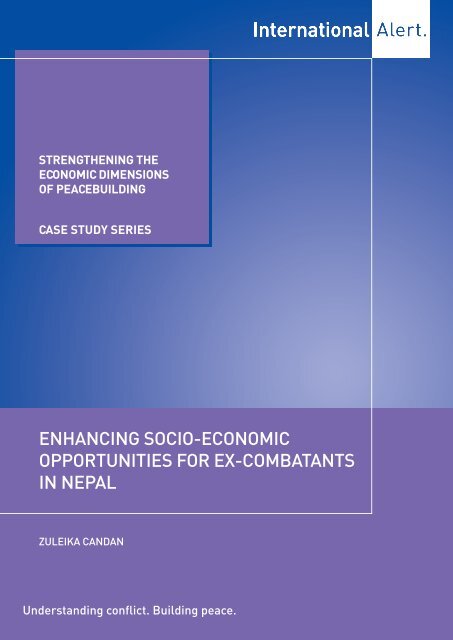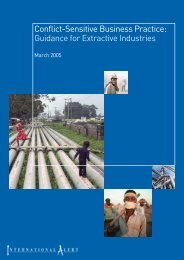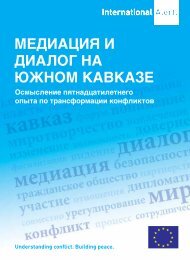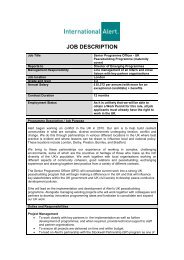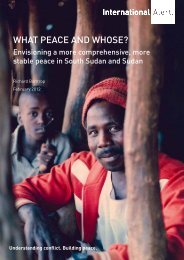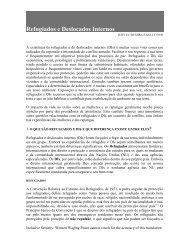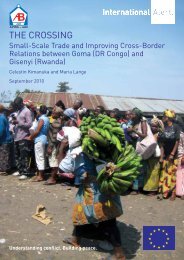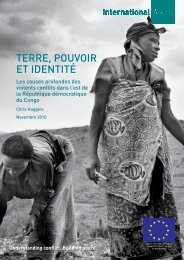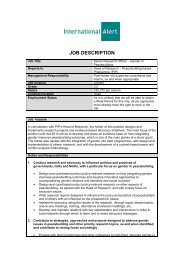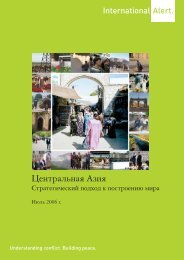strengthening the economic dimensions of ... - International Alert
strengthening the economic dimensions of ... - International Alert
strengthening the economic dimensions of ... - International Alert
Create successful ePaper yourself
Turn your PDF publications into a flip-book with our unique Google optimized e-Paper software.
STRENGTHENING THE<br />
ECONOMIC DIMENSIONS<br />
OF PEACEBUILDING<br />
CASE STUDY SERIES<br />
Enhancing socio-Economic<br />
opportUnitiEs for Ex-comBatants<br />
in nEpaL<br />
ZULEika candan<br />
Understanding conflict. Building peace.
2 <strong>International</strong> <strong>Alert</strong><br />
about international alert<br />
<strong>International</strong> <strong>Alert</strong> is a 26-year-old independent peacebuilding organisation. We work with people who<br />
are directly affected by violent conflict to improve <strong>the</strong>ir prospects <strong>of</strong> peace. And we seek to influence<br />
<strong>the</strong> policies and ways <strong>of</strong> working <strong>of</strong> governments, international organisations like <strong>the</strong> UN and<br />
multinational companies, to reduce conflict risk and increase <strong>the</strong> prospects <strong>of</strong> peace.<br />
We work in Africa, several parts <strong>of</strong> Asia, <strong>the</strong> South Caucasus, <strong>the</strong> Middle East and Latin America, and<br />
have recently started work in <strong>the</strong> UK. Our policy work focuses on several key <strong>the</strong>mes that influence<br />
prospects for peace and security – <strong>the</strong> economy, climate change, gender, <strong>the</strong> role <strong>of</strong> international<br />
institutions, <strong>the</strong> impact <strong>of</strong> development aid, and <strong>the</strong> effect <strong>of</strong> good and bad governance.<br />
We are one <strong>of</strong> <strong>the</strong> world’s leading peacebuilding NGOs with more than 159 staff based in London and<br />
14 field <strong>of</strong>fices. To learn more about how and where we work, visit www.international-alert.org.<br />
about this series<br />
This is part <strong>of</strong> a series <strong>of</strong> case studies which explore <strong>the</strong> socio-<strong>economic</strong> aspects <strong>of</strong> reintegration<br />
programmes for ex-combatants in a number <strong>of</strong> conflict-affected countries where <strong>International</strong> <strong>Alert</strong><br />
works: Nepal, Liberia and Uganda. The aim is to stimulate discussions at <strong>the</strong> local, national and<br />
international level about <strong>the</strong> role that private sector actors can play in <strong>the</strong> effective reintegration <strong>of</strong><br />
ex-combatants, and to streng<strong>the</strong>n practice by developing recommendations for future socio-<strong>economic</strong><br />
reintegration programmes.<br />
acknowledgements<br />
The research and publication <strong>of</strong> <strong>the</strong>se case studies has been made possible with <strong>the</strong> generous<br />
financial support <strong>of</strong> <strong>the</strong> Norwegian Ministry <strong>of</strong> Foreign Affairs.<br />
The author would like to thank <strong>the</strong> many people in Kathmandu and <strong>the</strong> field research locations who<br />
shared <strong>the</strong>ir time, knowledge and experiences. She is also grateful to Bijay Chhetri, Sarbani Kattel and<br />
Rekha Khatri, who conducted <strong>the</strong> field research, as well as Richard Reeve, Rebecca Crozier and Nisha<br />
Pandey for <strong>the</strong>ir contributions to this study.<br />
© <strong>International</strong> <strong>Alert</strong> 2012<br />
All rights reserved. No part <strong>of</strong> this publication may be reproduced, stored in a retrieval system or transmitted in any form or<br />
by any means, electronic, mechanical, photocopying, recording or o<strong>the</strong>rwise, without full attribution.<br />
Layout by D. R. ink, www.d-r-ink.com
introduction<br />
Enhancing socio-Economic opportunitiEs for Ex-combatants in nEpal<br />
Nepal is recovering from a decade-long conflict which ended with a ceasefire and <strong>the</strong> signing <strong>of</strong> a<br />
Comprehensive Peace Accord (CPA) in 2006. As part <strong>of</strong> <strong>the</strong> CPA Maoist ex-combatants were given<br />
<strong>the</strong> options <strong>of</strong> voluntary retirement, rehabilitation or reintegration into <strong>the</strong> Nepalese armed forces.<br />
This case study focuses on <strong>the</strong> rehabilitation 1 initiative which <strong>the</strong> United Nations Inter-Agency<br />
Rehabilitation Programme (UNIRP) implemented at <strong>the</strong> request <strong>of</strong> <strong>the</strong> government <strong>of</strong> Nepal for<br />
those ex-combatants who were ei<strong>the</strong>r minors or late recruits. It examines <strong>the</strong> outcomes <strong>of</strong> <strong>the</strong><br />
process at it stood in 2011 2 and highlights <strong>the</strong> role that <strong>the</strong> private sector can play in <strong>the</strong> successful<br />
rehabilitation <strong>of</strong> ex-combatants.<br />
Background<br />
Conflict erupted in 1996 when <strong>the</strong> <strong>the</strong>n Communist Party <strong>of</strong> Nepal (hereafter referred to as Maoists)<br />
launched a so-called “people’s war” 3 and Maoist combatants carried out a series <strong>of</strong> attacks against<br />
government services and private businesses. Their goal was to overthrow <strong>the</strong> monarchy and establish<br />
a republic. By <strong>the</strong> time <strong>the</strong> CPA was signed in 2006, more than 15,000 people had died and up to<br />
150,000 had been displaced. Both sides in <strong>the</strong> conflict were accused <strong>of</strong> targeting civilians. 4<br />
In accordance with <strong>the</strong> terms <strong>of</strong> <strong>the</strong> CPA, Maoist ex-combatants were confined to seven major<br />
cantonments (i.e. permanent military stations) and 28 small satellite camps while <strong>the</strong> government<br />
<strong>of</strong> Nepal and <strong>the</strong> Maoists negotiated <strong>the</strong>ir integration into <strong>the</strong> Nepali security sector. A validation<br />
exercise, which <strong>the</strong> United Nations Mission in Nepal (UNMIN) carried out in 2007, resulted in <strong>the</strong><br />
registration <strong>of</strong> 23,610 Maoist ex-combatants, <strong>of</strong> which 4,008 were verified minors and late recruits<br />
(VMLRs). 5 The VMLRs remained in <strong>the</strong> designated cantonments until <strong>the</strong>ir release in 2010 and<br />
<strong>the</strong>reafter became eligible for a rehabilitation package implemented by UNIRP.<br />
<strong>the</strong> situation in late 2011–early 2012<br />
The agreement reached by <strong>the</strong> government and <strong>the</strong> Maoists in November 2011 stipulated that a<br />
maximum <strong>of</strong> 6,500 ex-combatants could be integrated into <strong>the</strong> Nepali security forces. Registered<br />
ex-combatants who did not fall into <strong>the</strong> category <strong>of</strong> VMLRs were subsequently given <strong>the</strong> options<br />
<strong>of</strong> integration, rehabilitation or a one-<strong>of</strong>f payment <strong>of</strong> $11,500 upon retiring. Those who would<br />
choose integration would need to undergo a qualification process and, upon fulfilling certain preagreed<br />
criteria, would be able to join <strong>the</strong> security forces. 6 3,129 ex-combatants had decided to<br />
seek integration into <strong>the</strong> army, while 6,576 had opted for voluntary retirement by early 2012. 7 The<br />
oversubscription on early retirement was partly a result <strong>of</strong> ambiguities in <strong>the</strong> directives governing<br />
<strong>the</strong> process. 8<br />
1 In Nepal reintegration <strong>of</strong> ex-combatants is a sensitive issue as it implies reintegration into <strong>the</strong> Nepali army. Rehabilitation, <strong>the</strong>refore, is<br />
<strong>the</strong> generally accepted term for initiatives geared towards socio-<strong>economic</strong> reintegration.<br />
2 The research for this case study was carried out in 2010 and 2011. Following its completion, <strong>the</strong> context with regard to <strong>the</strong> rehabilitation<br />
<strong>of</strong> ex-combatants in Nepal changed rapidly. The information and recommendations in <strong>the</strong> present case study are <strong>the</strong>refore based on <strong>the</strong><br />
situation as it stood in late 2011. The case study none<strong>the</strong>less contains lessons learnt which may be <strong>of</strong> use to those working to design and<br />
implement sustainable socio-<strong>economic</strong> reintegration programmes.<br />
3 The Maoists popularly used <strong>the</strong> term “people’s war” to describe <strong>the</strong> civil war <strong>the</strong>y had initiated, whereas <strong>the</strong> state referred to it as<br />
“armed conflict”.<br />
4 <strong>International</strong> Crisis Group (2010). Nepal: Peace and justice, Asia Report, No. 184. Available at http://www.crisisgroup.org/en/regions/<br />
asia/south-asia/nepal/184-nepal-peace-and-justice.aspx<br />
5 VMLR refers to those ex-combatants who were minors at <strong>the</strong> time <strong>of</strong> registration (2007) and those recruited after <strong>the</strong> signing <strong>of</strong> <strong>the</strong> CPA (2006).<br />
6 <strong>International</strong> Crisis Group (2011). Nepal’s peace process: The endgame nears, Asia Report, No. 131. Available at http://www.crisisgroup.<br />
org/en/publication-type/media-releases/2011/asia/nepal-s-peace-process-<strong>the</strong>-endgame-nears.aspx<br />
7 ‘3,129 for integration’, Republica, 20th April 2012. Available at http://www.myrepublica.com/portal/index.php?action=news_details&news_<br />
id=34107<br />
8 ‘Integration number likely to be around 3,000’, Republica, 15th April 2012. Available at http://www.myrepublica.com/portal/index.<br />
php?action=news_details&news_id=33932<br />
3
4 <strong>International</strong> <strong>Alert</strong><br />
Economic context<br />
At <strong>the</strong> time <strong>of</strong> <strong>the</strong> signing <strong>of</strong> <strong>the</strong> CPA Nepal was one <strong>of</strong> <strong>the</strong> least developed countries in <strong>the</strong> world. 9<br />
The majority <strong>of</strong> <strong>the</strong> population was dependent on subsistence farming, although many family farms<br />
were too small to provide sufficient income. Land ownership was concentrated in <strong>the</strong> hands <strong>of</strong> an<br />
elite. GDP was made up <strong>of</strong> industry (21.6 percent) and services (37.8 percent), with manufacturing<br />
and tourism contributing less than 10 percent each. The conflict itself had a significant impact<br />
on <strong>the</strong> economy. It disrupted transport links, shut down factories and gave rise to widespread<br />
extortion in <strong>the</strong> industry sector, bringing <strong>the</strong> economy to a virtual standstill. 10<br />
In 2011 agriculture contributed 33 percent <strong>of</strong> GDP and this share was expected to grow. Industrial<br />
development had been slow due to power shortages, frequent strikes, insecurity and poor<br />
infrastructure. The service sector was driven by a gradual rise in tourism, telecommunications and<br />
social services. The fertile Terai lowland had <strong>the</strong> potential to benefit Nepal through cross-border<br />
trade with neighbouring India. The region produced wheat and pulses and was also home to agrobased<br />
industries such as rice mills and tobacco factories. Yet, <strong>the</strong> trade deficit with India continued<br />
to be one <strong>of</strong> <strong>the</strong> country’s <strong>economic</strong> woes. The hilly and mountainous areas, including <strong>the</strong> region<br />
from where <strong>the</strong> Maoist civil war had sprung, remained <strong>the</strong> least developed and most poverty<br />
stricken areas in Nepal.<br />
9 United Nations Development Programme (UNDP) (2006). Human development report 2006 – Beyond scarcity: Power, poverty and <strong>the</strong> global<br />
water crisis. New York. Available at http://hdr.undp.org/en/media/HDR06-complete.pdf<br />
10 <strong>International</strong> <strong>Alert</strong> (2006). Local business, local peace: The peacebuilding potential <strong>of</strong> <strong>the</strong> domestic private sector, Section 2: Nepal case<br />
study. Available at http://www.international-alert.org/resources/publications/local-business-local-peace
Enhancing socio-Economic opportunitiEs for Ex-combatants in nEpal<br />
<strong>the</strong> disarmament, demobilisation and rehabilitation process<br />
An additional agreement, which <strong>the</strong> government and <strong>the</strong> Maoists reached following <strong>the</strong> signing <strong>of</strong><br />
<strong>the</strong> CPA in 2006, stipulated that VMLRs would not be eligible for integration into <strong>the</strong> armed forces.<br />
In 2010, 4,008 VMLRs were allowed to leave <strong>the</strong> cantonments and were <strong>of</strong>fered rehabilitation<br />
packages. The process was led by UNIRP. UNIRP <strong>of</strong>fered psycho-social counselling to VMLRs<br />
and <strong>the</strong>ir families as well as medical care, where needed. Participants could sign up to any <strong>of</strong> <strong>the</strong><br />
available packages up to 12 months after <strong>the</strong>ir <strong>of</strong>ficial discharge ceremony. The rehabilitation<br />
options which were available included:<br />
• Vocational skills training (e.g. welder, electrician, mechanic, cook, hotel housekeeper, dental<br />
lab assistant, floriculture assistant, etc);<br />
• Micro-enterprise development (technical and business training, e.g. in food processing and<br />
preparation, handicrafts, tailoring, cycle repair, catering services, etc);<br />
• Health-related training and education (e.g. auxiliary nurse midwife, community medical<br />
assistant, laboratory assistant, etc);<br />
• Formal or informal education (e.g. bridging courses as part <strong>of</strong> primary and secondary<br />
education and some opportunities for higher secondary and higher education, etc).<br />
UN Inter-Agency Rehabilitation Programme<br />
• By December 2011, 396 participants had completed vocational skills training and a<br />
fur<strong>the</strong>r 39 were in training. The programme also <strong>of</strong>fered <strong>the</strong>m career counselling and<br />
mentoring. The Indian cooking course was <strong>the</strong> most popular option in this package.<br />
• 643 participants had graduated and ano<strong>the</strong>r 507 had chosen <strong>the</strong> micro-enterprise option.<br />
This option entailed an 11-day business introduction course and provided <strong>the</strong>m with basic<br />
start-up skills as well as <strong>the</strong> possibility to apply for start-up capital. The most popular<br />
choices were tailoring and mobile phone repair.<br />
• 425 participants opted for education. Education was provided through government-run<br />
schools and <strong>the</strong> programme included admission, annual school fees, uniforms and a<br />
monthly stipend.<br />
• 58 participants chose health-related training and education. This option included a 15- to<br />
18-month course and a 3-month on-<strong>the</strong>-job training.<br />
• 60% <strong>of</strong> all graduates had found employment or had established <strong>the</strong>ir own businesses.<br />
• 1,040 participants had completed one <strong>of</strong> <strong>the</strong> four options and 565 <strong>of</strong> <strong>the</strong>m were ei<strong>the</strong>r selfemployed<br />
or employed. 2% <strong>of</strong> participants had dropped out.<br />
For more information, see http://www.undp.org.np/crisis-prevention-and-recovery/program/<br />
unirp-113.html<br />
Many VMLRs had left <strong>the</strong> cantonments prior to <strong>the</strong>ir <strong>of</strong>ficial discharge in 2010. There was a sense<br />
<strong>of</strong> being side-lined and resentment at not being considered formal ex-combatants. This translated<br />
into general reluctance to participate in <strong>the</strong> rehabilitation programme, which in turn lessened <strong>the</strong><br />
success <strong>of</strong> <strong>the</strong> process. The weak state <strong>of</strong> Nepal’s economy and VMLRs’ relatively high mobility also<br />
served as inhibiting factors, as <strong>the</strong>y impacted on <strong>the</strong> ability <strong>of</strong> VMLRs to find gainful employment<br />
upon <strong>the</strong> completion <strong>of</strong> <strong>the</strong>ir chosen training. Misalignment between <strong>the</strong> courses on <strong>of</strong>fer and <strong>the</strong><br />
needs <strong>of</strong> <strong>the</strong> labour market, as well as inadequate subsistence allowances for VMLRs in training,<br />
posed additional challenges. The different training options moreover <strong>of</strong>fered different benefits<br />
packages, leading participants to choose courses which would accommodate <strong>the</strong>ir immediate<br />
needs ra<strong>the</strong>r than improve <strong>the</strong>ir long-term livelihood opportunities.<br />
5
6 <strong>International</strong> <strong>Alert</strong><br />
The information that was provided to VMLRs and <strong>the</strong> general public was fur<strong>the</strong>rmore scarce.<br />
Interviews with VMLRs and community members, which <strong>International</strong> <strong>Alert</strong> conducted in 2010<br />
across various regions, revealed that <strong>the</strong>re had been very little communication regarding what<br />
disarmament, demobilisation and rehabilitation (DDR) options were available as part <strong>of</strong> <strong>the</strong> UNIRP<br />
programme. Although UNIRP had made some efforts to engage businesspeople in supporting<br />
<strong>the</strong> <strong>economic</strong> rehabilitation <strong>of</strong> trainees, <strong>the</strong> private sector had had only limited involvement in <strong>the</strong><br />
actual design <strong>of</strong> <strong>the</strong> programme. This translated into a general lack <strong>of</strong> knowledge on <strong>the</strong> part <strong>of</strong><br />
businesses about <strong>the</strong> rehabilitation process and inhibited <strong>the</strong> success <strong>of</strong> <strong>the</strong> programme. Training<br />
was not necessarily aligned with employers’ needs and graduates had limited opportunities to<br />
benefit from business support services. VMLRs who gravitated towards urban centres posed<br />
additional complications. Not only did <strong>the</strong>ir mobility hamper UNIRP’s efforts to reach out to <strong>the</strong>m<br />
for inclusion in <strong>the</strong> rehabilitation programme but it also made it difficult for VMLRs to join training<br />
modules which were located in o<strong>the</strong>r regions.<br />
Affiliation with <strong>the</strong> Maoists was a particularly contentious issue. <strong>Alert</strong> interviewees from <strong>the</strong> private<br />
sector repeatedly expressed suspicions towards VMLRs. Despite <strong>the</strong> labour shortages which Nepal<br />
was experiencing at <strong>the</strong> time, businesses were reluctant to hire ex-combatants. They feared that<br />
<strong>the</strong> latter might join highly politicised trade unions, <strong>the</strong>reby inciting labour unrest and employeremployee<br />
tensions. Many also expressed concern that VMLRs would retain <strong>the</strong>ir links with <strong>the</strong><br />
Maoists, leading to a politicisation <strong>of</strong> <strong>the</strong> workplace. Providers <strong>of</strong> training courses also confirmed<br />
that some VMLRs would not join <strong>the</strong> rehabilitation programme unless <strong>the</strong>y had been advised to do<br />
so by <strong>the</strong> party.
Outcomes<br />
Enhancing socio-Economic opportunitiEs for Ex-combatants in nEpal<br />
Throughout <strong>the</strong> conflict, which was largely justified by <strong>the</strong> Maoists as a class war, <strong>the</strong> private<br />
sector was subjected to continuous attacks. These involved frequent extortion and kidnappings.<br />
The strained relationship between <strong>the</strong> Maoists, <strong>the</strong>ir affiliated unions and <strong>the</strong> private sector had<br />
an impact on <strong>the</strong> rehabilitation <strong>of</strong> VMLRs. On <strong>the</strong> one hand, VMLRs had developed a negative<br />
perception <strong>of</strong> private sector actors, while on <strong>the</strong> o<strong>the</strong>r hand <strong>the</strong> private sector remained suspicious<br />
<strong>of</strong> employing persons linked to <strong>the</strong> communist party.<br />
<strong>Alert</strong>’s research into perceptions within <strong>the</strong> private sector in eight districts revealed that business<br />
was generally aware <strong>of</strong> <strong>the</strong> need and inherent value <strong>of</strong> reintegrating ex-combatants into society<br />
and <strong>the</strong> economy. Private sector representatives were also cautiously willing to support <strong>the</strong><br />
rehabilitation <strong>of</strong> former combatants but frequently expressed <strong>the</strong> view that vocational training<br />
alone would not suffice. They stressed <strong>the</strong> need for life skills coaching and long-term support as<br />
a means <strong>of</strong> instilling a strong work ethic in ex-combatants. The latter would <strong>of</strong>ten be perceived<br />
as not having <strong>the</strong> “right” attitude and a commitment to hard work. There had been no concerted<br />
efforts made by <strong>the</strong> UN, <strong>the</strong> government <strong>of</strong> Nepal and o<strong>the</strong>r relevant stakeholders to change <strong>the</strong><br />
perceptions held by <strong>the</strong> business community towards those associated with <strong>the</strong> Maoist conflict.<br />
Business representatives thus sought guarantees that VMLRs had no fur<strong>the</strong>r links with <strong>the</strong> party<br />
or that <strong>the</strong>y had participated in behavioural change programmes to ensure that <strong>the</strong>y would no<br />
longer resort to violent means. This reflected a common fear that former Maoist combatants would<br />
readily be prepared to use violence because <strong>of</strong> <strong>the</strong>ir previous experience.<br />
‘There are chances that <strong>the</strong>y (ex-combatants) might feel isolated if <strong>the</strong> government and wider<br />
society do not show concern for <strong>the</strong> rehabilitation process, which in turn will encourage <strong>the</strong>m to<br />
follow <strong>the</strong> wrong path.’ 11<br />
Against this background, <strong>Alert</strong>’s research revealed that VMLRs who subscribed to <strong>the</strong> UNIRP<br />
programme had high expectations <strong>of</strong> <strong>the</strong>ir future employment prospects. They anticipated<br />
that UNIRP would provide jobs, facilitate access to loans and <strong>of</strong>fer advanced training for those<br />
interested in starting <strong>the</strong>ir own business. Respondents fur<strong>the</strong>rmore expected that businesses and<br />
o<strong>the</strong>r employers could provide <strong>the</strong>m with salaries substantially higher than <strong>the</strong> average. At <strong>the</strong><br />
same time, <strong>the</strong>re was little recognition on <strong>the</strong> part <strong>of</strong> those in <strong>the</strong> private sector that <strong>the</strong> labour<br />
shortages <strong>the</strong>y had identified in <strong>the</strong>ir respective regions might not necessarily mean that good jobs<br />
were in fact available. In some cases, compensation structures and employment conditions might<br />
indeed have been perceived as inadequate by job-seekers in general, not only by ex-combatants.<br />
11 Interview by <strong>International</strong> <strong>Alert</strong> and <strong>the</strong> National Business Initiative with a private sector representative on 10th December 2010 in<br />
Kathmandu.<br />
7
8 <strong>International</strong> <strong>Alert</strong><br />
Lessons learnt<br />
1. Poor communication and management <strong>of</strong> expectations can adversely impact on <strong>economic</strong><br />
rehabilitation efforts. Not only did misaligned expectations affect <strong>the</strong> willingness <strong>of</strong> VMLRs<br />
to join <strong>the</strong> UNIRP rehabilitation programme but such expectations also seem to have affected<br />
<strong>the</strong>ir ability to enter <strong>the</strong> labour market. In Chitwan and Kailali districts, for instance, <strong>the</strong><br />
majority <strong>of</strong> opportunities highlighted by private sector respondents were in agriculture.<br />
<strong>Alert</strong>’s assessment <strong>of</strong> VMLRs’ expectations indicated, however, that most did not regard<br />
farming as an attractive or viable option for <strong>the</strong>ir future. This was largely due to VMLRs’<br />
previous experience with traditional subsistence farming and <strong>the</strong> low status accorded to that<br />
particular livelihood option. In this regard, a strong communication component could be used<br />
not only to manage expectations but also raise awareness <strong>of</strong> <strong>the</strong> roles and responsibilities <strong>of</strong><br />
different stakeholders, including <strong>the</strong> private sector. Moreover, <strong>the</strong> integration <strong>of</strong> trust-building<br />
dialogue processes in rehabilitation programmes could serve to address suspicion on <strong>the</strong><br />
part <strong>of</strong> business and ultimately, contribute to improving <strong>the</strong> employment prospects <strong>of</strong> excombatants.<br />
2. S<strong>of</strong>t skills training and long-term support can enhance <strong>the</strong> effectiveness <strong>of</strong> socio-<strong>economic</strong><br />
rehabilitation programmes. Such support could include psychological counselling to assist<br />
employers in dealing with issues related to <strong>the</strong> behaviour or attitude <strong>of</strong> ex-combatants.<br />
It could also include <strong>the</strong> provision <strong>of</strong> advanced training to former combatants interested<br />
in pursuing self-employment, follow-up training to address specific gaps identified once<br />
employment commences and trainings in communication or work ethics. Support in this<br />
regard is integral not only to addressing employers’ concerns but also to enabling excombatants<br />
to integrate successfully into civilian life.<br />
3. Early engagement with <strong>the</strong> private sector and close coordination among stakeholders is<br />
essential for <strong>the</strong> positive reception <strong>of</strong> ex-combatants into <strong>the</strong> labour market. Involvement<br />
<strong>of</strong> <strong>the</strong> private sector in <strong>the</strong> design phase <strong>of</strong> rehabilitation processes could help align training<br />
with local economy needs and lessen suspicion between formerly opposing parties to <strong>the</strong><br />
conflict. The establishment <strong>of</strong> coordination mechanisms involving businesses, government<br />
authorities and o<strong>the</strong>r stakeholders could also increase <strong>the</strong> likelihood <strong>of</strong> training graduates<br />
finding employment by providing a space for different actors to come toge<strong>the</strong>r and identify<br />
<strong>economic</strong> opportunities available to ex-combatants. It could fur<strong>the</strong>rmore provide <strong>the</strong><br />
rehabilitation programme with a support network to help address barriers to socio-<strong>economic</strong><br />
rehabilitation. In this regard, it is vital that <strong>the</strong> design process does not fall into <strong>the</strong> trap<br />
<strong>of</strong> consulting only with large national-level networks. Local chambers <strong>of</strong> commerce and<br />
associations should be engaged, toge<strong>the</strong>r with sector-specific networks at <strong>the</strong> national level.<br />
4. Support from government is key to facilitating private sector involvement and sustainable<br />
socio-<strong>economic</strong> rehabilitation programmes. Government authorities could play an important<br />
role in enabling access to credit for former combatants who would generally find it difficult to<br />
access loan facilities. In areas where agri-business, for instance, <strong>of</strong>fers prospects for gainful<br />
micro-enterprise development, <strong>the</strong> government could fur<strong>the</strong>rmore facilitate access to land.<br />
Government leadership is vital in creating a political environment conducive to successful<br />
socio-<strong>economic</strong> rehabilitation, including commitment from different stakeholders with a<br />
political stake in <strong>the</strong> process. In Nepal, engaging trade unions in dialogues and consultations,<br />
in an effort to secure <strong>the</strong>ir support, could have potentially enhanced employment<br />
opportunities for VMLRs.
conclusion<br />
Enhancing socio-Economic opportunitiEs for Ex-combatants in nEpal<br />
The rehabilitation programme in Nepal ultimately succeeded in reaching <strong>the</strong> majority <strong>of</strong> its 4,008<br />
target beneficiaries. While some VMLRs underwent training, o<strong>the</strong>rs received medical and psychosocial<br />
support. As in DDR processes elsewhere <strong>the</strong>re were tensions between ex-combatants’<br />
immediate versus long-term needs or interests, disagreements over funds for <strong>the</strong> provision <strong>of</strong><br />
<strong>the</strong> training modules and challenges posed by <strong>the</strong> realities <strong>of</strong> a post-conflict economy. Nepal has<br />
showcased that <strong>the</strong>re is a need to include private sector actors in DDR initiatives. <strong>Alert</strong>’s research<br />
has indicated that in order to provide long-term livelihood opportunities for ex-combatants, <strong>the</strong><br />
business community must be engaged in socio-<strong>economic</strong> rehabilitation efforts. Such engagement<br />
would not only help align vocational skills training with <strong>the</strong> needs <strong>of</strong> local economies, but also<br />
help counter misinformation and suspicion which may be rife between <strong>the</strong> parties following a<br />
conflict. Early private sector engagement is <strong>the</strong>refore intrinsically linked to <strong>the</strong> success <strong>of</strong> DDR<br />
programmes and, by extension, to sustainable peace.<br />
9
international alert.<br />
346 Clapham Road, London SW9 9AP, United Kingdom<br />
tel +44 (0)20 7627 6800, fax +44 (0)20 7627 6900<br />
general@international-alert.org<br />
www.international-alert.org<br />
ISBN: 978-1-906677-34-3


